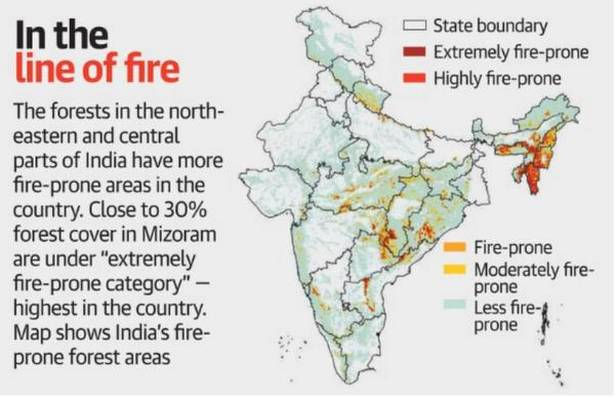Description

Disclaimer: Copyright infringement not intended.
Context
Several wildfires have erupted in Himachal Pradesh as a result of a protracted dry season combined with exceptionally high temperatures in recent days, damaging several hectares of forest cover across the hill state.
Background
The early beginning of summer in the hills this year created a big challenge for the State government's attempts to suppress forest fires, and the work has gotten more difficult with dry weather conditions and high temperatures projected to persist in the days ahead.
Wildfires
- It may be defined as any unregulated and unprescribed combustion or burning of plants in a natural context such as a forest, grassland, brush land, or tundra, which utilises natural fuels and spreads dependent on environmental circumstances (e.g., wind, topography).
Causes for Forest fires
- Human-caused forest fires can be sparked by land removal, acute drought, or, in rare situations, lightning.
- A wildfire must have three conditions in order to burn: fuel, oxygen, and a heat source.
- Lightning is responsible for a large number of wildfires. A spark can be created by a lightning strike. Lightning can hit electricity wires, trees, rocks, and other objects, causing a fire.
- People frequently leave lighted flames or combustible objects unattended while camping or outdoor activities, resulting in wildfires.
- During a volcanic eruption, hot magma in the earth's crust is frequently ejected as lava. The molten lava then pours into neighbouring fields or lands, causing flames to erupt.
Impact of Forest Fires
- Forest fires have a variety of negative consequences for the forest cover, soil, tree development, vegetation, and general flora and fauna.
- Several hectares of woodland are rendered worthless by fires, which leave behind ash that is unsuited for plant development.
- Wastes and trash have been reduced to ashes on multiple occasions in order to reduce the accumulation of garbage.
- The woods are becoming increasingly fragile as a result of rising temperatures caused by global warming.
Vulnerability of India’s forests
- According to the India State of Forest Report 2021 (ISFR) produced by the Forest Survey of India (FSI), Dehradun, forest and tree cover of the countryis 80.9 million hectares which are 62 per cent of the geographical area of the country.
- The overall forest and tree cover of the nation has increased by 2,261 sq km since the last assessment in 2019.
- Forests in the Northeast and central India regions are the most prone to forest fires, according to historical fire events and data.
- Forest fires have been classified as being 'particularly prone' in Assam, Mizoram, and Tripura.
- Andhra Pradesh, Manipur, Meghalaya, Mizoram, Nagaland, Odisha, Maharashtra, Bihar, and Uttar Pradesh are among the states with extensive forest regions classified as "extremely highly prone."
- The 'extremely prone' and'moderately prone' groups account for around 26.2 percent of total forest cover, or 1,72,374 square kilometres.
How to prevent?
- To unify current recommendations and publish complete guidelines that are compatible with climate change objectives, a national policy is necessary.
- States would be able to invent new science-based management measures for avoiding fires and rehabilitating fire-affected regions if they collaborated more closely with State Forest Departments (SFDs), disaster management authorities, and research bodies.
- Early warning and fire hazard systems must be created. Integrating ground-based detection with satellite-based alert systems can also improve fire alert systems.
As a result of global warming, the number of forest fires has increased. Forest destruction is a disaster that requires quick solution. A quick first strike is necessary, followed by a strong follow-up action. Research, training, and development should all be prioritised.
https://epaper.thehindu.com/Home/ShareArticle?OrgId=GRQ9P1MJG.1&imageview=0
















